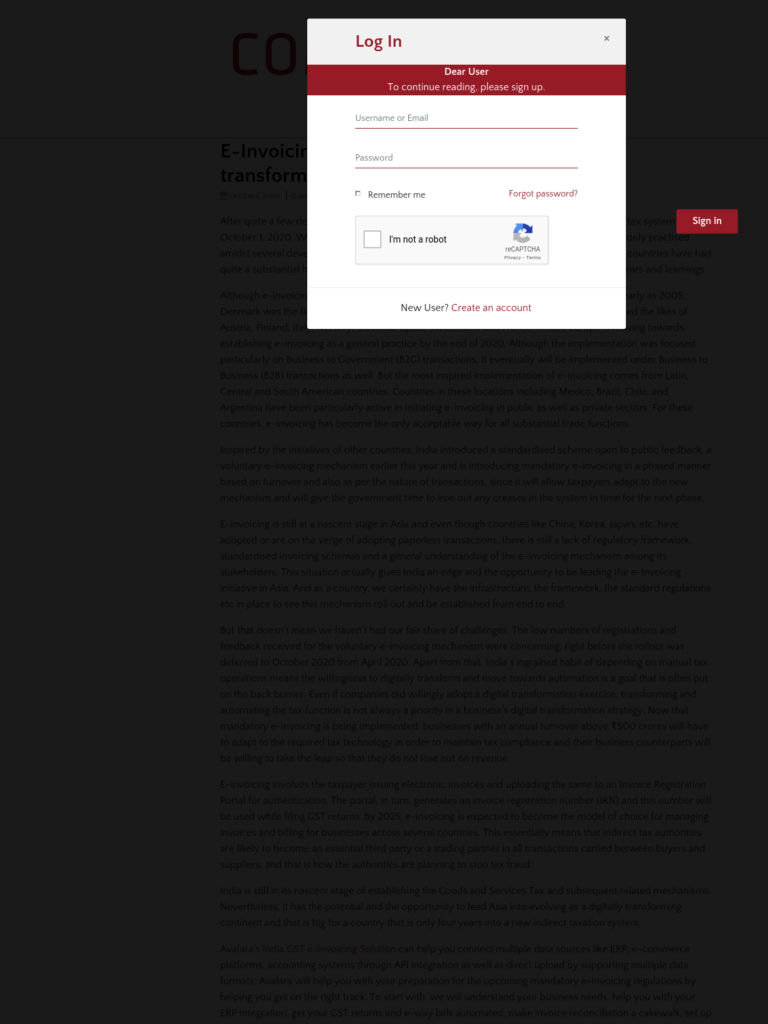E-Invoicing – India’s road ahead for digital transformation and tax automation
Blog: NASSCOM Official Blog
After quite a few delays and disruptions, e-invoicing is all set to roll out in the Indian indirect tax system starting October 1, 2020. While e-invoicing is new to India, it has been long implemented and commonly practised amidst several developing as well as developed nations across the globe. The fact that other countries have had quite a substantial head start is actually a great way for India to learn and adapt from their errors and learnings.
Although e-invoicing may be a new concept for India, it was adopted by other countries as early as 2005. Denmark was the first European country to implement mandatory e-invoicing and this inspired the likes of Austria, Finland, Italy, Norway, Slovenia, Spain, Switzerland and France. In fact, Europe is moving towards establishing e-invoicing as a general practice by the end of 2020. Although the implementation was focused particularly on Business to Government (B2G) transactions, it eventually will be implemented under Business to Business (B2B) transactions as well. But the most inspired implementation of e-invoicing comes from Latin, Central and South American countries. Countries in these locations including Mexico, Brazil, Chile, and Argentina have been particularly active in initiating e-invoicing in public as well as private sectors. For these countries, e-invoicing has become the only acceptable way for all substantial trade functions.
Inspired by the initiatives of other countries, India introduced a standardised scheme open to public feedback, a voluntary e-invoicing mechanism earlier this year and is introducing mandatory e-invoicing in a phased manner based on turnover and also as per the nature of transactions, since it will allow taxpayers adapt to the new mechanism and will give the government time to iron out any creases in the system in time for the next phase.
E-invoicing is still at a nascent stage in Asia and even though countries like China, Korea, Japan, etc. have adopted or are on the verge of adopting paperless transactions, there is still a lack of regulatory framework, standardised invoicing schemas and a general understanding of the e-invoicing mechanism among its stakeholders. This situation actually gives India an edge and the opportunity to be leading the e-Invoicing initiative in Asia. And as a country, we certainly have the infrastructure, the framework, the standard regulations etc in place to see this mechanism roll out and be established from end to end.
But that doesn’t mean we haven’t had our fair share of challenges. The low numbers of registrations and feedback received for the voluntary e-invoicing mechanism were concerning, right before the rollout was deferred to October 2020 from April 2020. Apart from that, India’s ingrained habit of depending on manual tax operations means the willingness to digitally transform and move towards automation is a goal that is often put on the back burner. Even if companies did willingly adopt a digital transformation exercise, transforming and automating the tax function is not always a priority in a business’s digital transformation strategy. Now that mandatory e-invoicing is being implemented, businesses with an annual turnover above ₹500 crores will have to adapt to the required tax technology in order to maintain tax compliance and their business counterparts will be willing to take the leap so that they do not lose out on revenue.
E-invoicing involves the taxpayer issuing electronic invoices and uploading the same to an Invoice Registration Portal for authentication. The portal, in turn, generates an invoice registration number (IRN) and this number will be used while filing GST returns. By 2025, e-invoicing is expected to become the model of choice for managing invoices and billing for businesses across several countries. This essentially means that indirect tax authorities are likely to become an essential third party or a trading partner in all transactions carried between buyers and suppliers, and that is how the authorities are planning to stop tax fraud.
India is still in its nascent stage of establishing the Goods and Services Tax and subsequent related mechanisms. Nevertheless, it has the potential and the opportunity to lead Asia into evolving as a digitally transforming continent and that is big for a country that is only four years into a new indirect taxation system.
Avalara’s India GST e-Invoicing Solution can help you connect multiple data sources like ERP, e-commerce platforms, accounting systems through API integration as well as direct upload by supporting multiple data formats. Avalara will help you with your preparation for the upcoming mandatory e-invoicing regulations by helping you get on the right track. To start with, we will understand your business needs, help you with your ERP integration, get your GST returns and e-way bills automated, make invoice reconciliation a cakewalk, set up GST calculation engine, support GST registration, if required.
For more information on GST compliance, visit https://www.avalara.com/in/en/index.html
To Know more about Avalara GST Solution please click here –
https://www.avalara.com/simplify/en/india/gst-return-filing.html
The post E-Invoicing – India’s road ahead for digital transformation and tax automation appeared first on NASSCOM Community |The Official Community of Indian IT Industry.
Leave a Comment
You must be logged in to post a comment.








